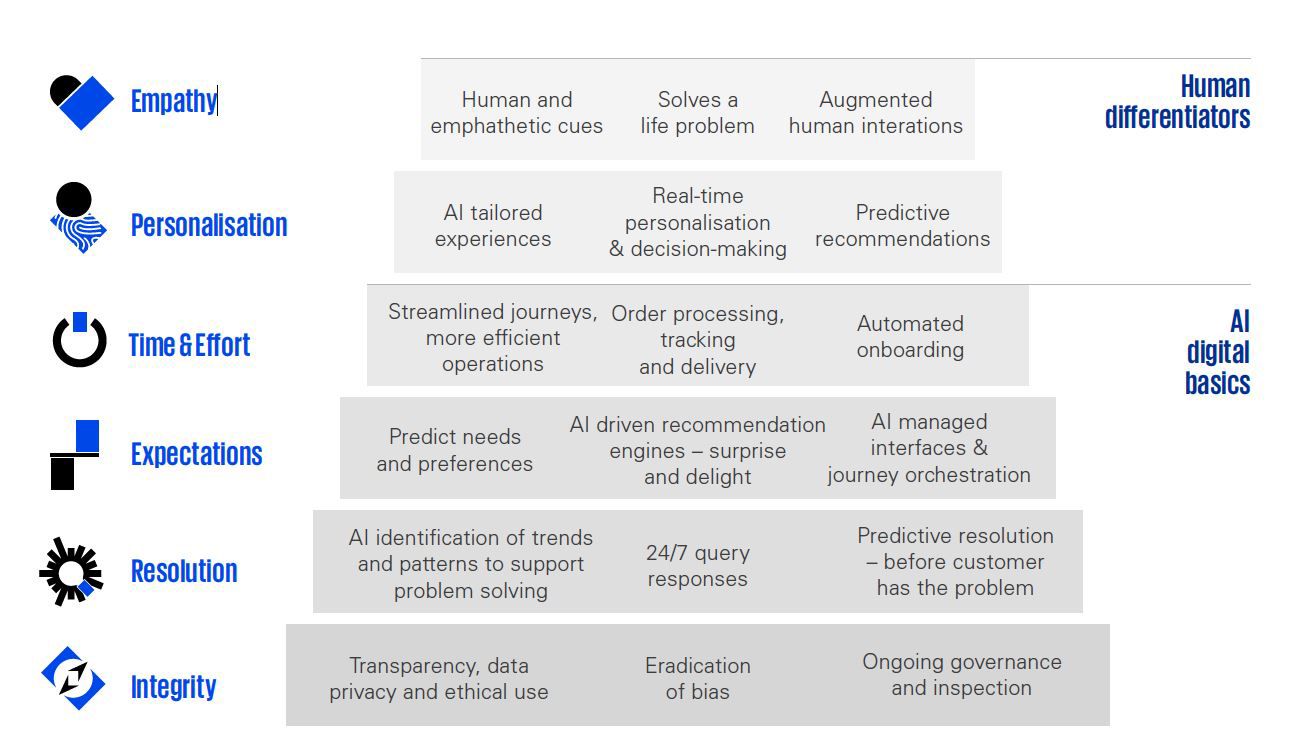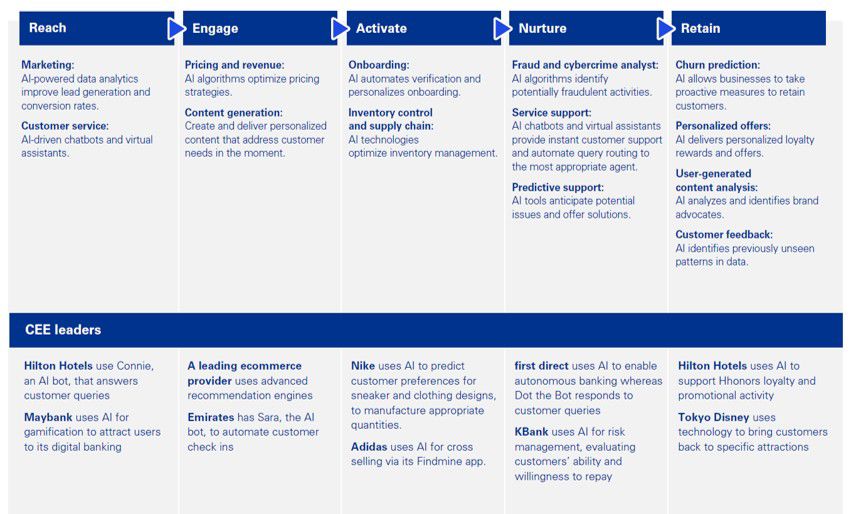The advancement of Artificial Intelligence (AI) is profoundly altering the business landscape, transforming industries, and enhancing customer experiences in significant ways. ChatGPT has elevated expectations towards AI's potential, leading to the development of new business applications and the anticipation of economic benefits through improved efficiency, cost reductions, and increased revenue generation.
AI's impact is widespread, ushering in an era where personalized, predictive, and efficient customer service becomes the norm. This global trend, characterized by rapid innovation and a focus on customer-centric solutions, is shaping the future of business interactions and customer satisfaction. Companies are increasingly aware of AI's disruptive potential and the imperative to adapt in order to avoid being left behind.
Amid economic uncertainty, CEOs around the globe are prioritizing investments in Generative AI, signaling its critical role in future success. The KPMG 2023 CEO Report highlights that 70% of CEOs are concentrating their investments on AI, with expectations of seeing returns within three to five years. Furthermore, 68% of leading companies now consider AI indispensable for achieving their immediate objectives.
This shift towards AI, including the rise of Generative AI, represents more than just the adoption of new technology; it signifies a fundamental transformation in how businesses operate, innovate and engage with their customers. As companies seek to leverage AI, they are also confronted with new risks and challenges that must be managed. This evolution demands strategic foresight and adaptability, highlighting the critical role of AI in driving future business success.
AI and the Six Pillars of excellence
KPMG’s Six Pillars of Customer Experience Excellence (Six Pillars) are essential characteristics needed to drive superior customer results. Even in a world fueled by technology, the Six Pillars still define the DNA of outstanding customer experiences. They act as design principles, providing guidance on how to incorporate best practice into world-class customer journeys.
The Six Pillars, when applied together, provide a powerful mechanism to help organizations understand how well their customer experience is delivered across channels, industries, and company types. In this new age of AI, they are not only relevant, but an essential consideration if organizations are to maximize customer opportunities and minimize the risks.
The reasons customers become dissatisfied with an experience differ to what drives their advocacy and loyalty. Consequently, there is a Maslovian hierarchy to take into account when focusing on the pillars. For example, there is little value in focusing on developing personalization or empathy if there is poor lower order performance undermining trust and causing dissatisfaction and negative comments.
When implementing AI, the hierarchy highlights where organizational efforts can be best focused. It fixes the basics by removing the causes of mistrust, unresolved issues, and unmet expectations. Human differentiation is driven when the customer finds the organization easy to use, suited to their personal circumstances and feels that the organization cares about them.
How digital transformation can support each of the Six Pillars
heading
Using AI responsibly and ethically, focusing on transparency, data privacy, and fairness, is essential for gaining customer trust. Companies committed to safeguarding customer well-being with AI are more likely to secure lasting trust and loyalty. Key areas of focus include ensuring data privacy, making AI decisions transparent and understandable, addressing biases in AI to prevent discriminatory outcomes, and adhering to ethical AI practices. Moreover, addressing concerns about AI and employment transparently can reassure customers about the positive role of AI in enhancing jobs. By addressing these challenges, organizations can strengthen, rather than undermine, customer trust in their AI initiatives.
heading
AI revolutionizes customer service by enhancing efficiency and the customer experience. It processes data quickly and accurately, leading to precise solutions and fewer errors. AI aids human agents by suggesting data-driven solutions, accelerating the resolution process. Chatbots and virtual assistants provide 24/7 responses, handling many inquiries simultaneously for faster service. Self-service options empower customers and reduce support team workload.
Complex queries are intelligently directed to human agents, optimizing their problem-solving skills. AI's adaptive learning from past interactions improves its effectiveness over time. It can proactively address potential issues, improving customer satisfaction, and analyze data to identify trends, helping businesses pinpoint and address common problems, refining their services and support strategies.
heading
AI is key in helping organizations not just meet but surpass customer expectations by using predictive analytics to foresee customer needs and preferences. It enables proactive service, offering relevant products and services before customers request them. AI-powered recommendation systems improve cross-selling and upselling opportunities, enhancing the shopping experience by tailoring suggestions to individual customer histories and preferences.
AI can help refine user interfaces, making them more intuitive and personalized based on user behavior, which enhances the customer experience. It automates processes like order processing, inventory management, and customer support, streamlining operations for greater efficiency and faster service. This automation smooths out the customer journey, reducing obstacles and boosting satisfaction.
heading
AI can streamline customer interactions with organizations by automating tasks and offering personalized help, saving customers time and effort. It quickly indexes and analyzes vast data, making it easier to find specific information, reducing search time.
AI can also manage order processes, tracking, and updates efficiently, eliminating waiting times for manual handling or customer support inquiries.
Using AI to automate the onboarding process for new customers – guiding them and providing relevant information promptly – ensures quick and accurate set up. Often, downstream problems occur due to errors in the onboarding process, but AI helps avoid this.
heading
AI elevates personalization by leveraging customer data to provide "hyper-personalized" experiences, segmenting customers for tailored content and recommendations. It dynamically adjusts digital interactions, such as website content, based on real-time user context for more relevant and engaging experiences.
AI-driven recommender systems boost engagement by suggesting products or content that match customer preferences, and it enhances email marketing by personalizing content, subject lines, and send times to individual preferences, increasing open and response rates.
Additionally, AI uses historical data to predict customer interests, allowing organizations to proactively present relevant offerings before the customer even searches for them.
heading
AI enhances organizational empathy by analyzing customer data for deeper insights into their needs, assisting in more empathetic responses. Through sentiment analysis, AI gauges emotional tones, enabling compassionate interaction. It also offers personalized training to staff, improving their empathy and emotional intelligence, and uses VR simulations for empathy-building scenarios. AI aids in creating a diverse workplace by reducing hiring biases, fostering broader empathy.
However, AI should complement human interaction, not replace it. Balancing AI with a personal touch is crucial for an empathetic environment. Training employees to use AI tools empathetically ensures AI's role in boosting emotional intelligence at work.
AI use cases
AI is a catch all phrase that covers a multitude of different technologies with different capabilities. Currently, there is much excitement around generative AI, and its ability to create content.
Going beyond simply analyzing or acting on existing data, generative AI models have been built and trained on a collated set of data that is used to produce content that directly responds to certain human-directed requests. Some models, for example, can predict the next word in a sentence based on learned phrases or the next image in a series based on previous image descriptions.
Generative AI applications can be roughly divided into five categories:
- Content generators: Generates content, such as blogs, emails, social media posts, images, web copy and ads based on specific instructions.
- Information extractors: Creates short- and long-form summaries of news articles, blogs, legal documents and more by analyzing inputted documents.
- Smart chatbots: Interacts with customers in a conversational way and is equipped to answer follow-up questions, admit mistakes, challenge incorrect ideas and reject inappropriate requests.
- Language translators: Translates many languages and has the potential to build entire website interfaces, including translation sites.
- Code generators: Converts natural text inputs into code snippets or applications in various programming languages, and can identify and fix bugs.
AI adoption: by sector
Future trends indicate that AI will play an increasingly significant role in enhancing customer experience (CX), with its influence expected to expand and integrate more deeply. AI is transforming the CX landscape through predictive analytics, personalized interactions, and seamless service across multiple channels.
These developments are not merely speculative but are supported by concrete trends and strategic planning, as outlined in this report. The potential for dramatic cost reductions and the strategic allocation of AI in areas that yield high returns underscore the importance of understanding AI's economic impact. Opportunities for significant advancements exist across all sectors.
We have summarized the trends and immediate opportunities across and in sectors.
AI is likely to drive the most value by focusing on:
- Improving knowledge management, making knowledge easier to access, aiding retrieval and automatically summarizing lengthy documents, making it easier for users to grasp essential information quickly.
- Integrating generative AI-powered chatbots into websites or messaging platforms to provide instant customer support, answer queries, guide users through processes and assist with product or service selection.
- Making personalized recommendations for customers based on their historical data, preferences and behaviors.
- By analyzing vast amounts of customer data, generative AI algorithms can produce tailored suggestions, such as personalized product recommendations, content recommendations or targeted marketing messages.
- This enhances customer engagement, improves conversion rates and drives customer satisfaction.
- Enabling the translation of text or documents between multiple languages, improving communication and facilitating collaboration across international teams or with global customers.
- Helping to leverage historical data, market trends, competitor behavior, strategic priorities and other relevant factors to generate accurate forecasts for enterprise- level planning and future skill requirements. It can provide insights into future demand, revenue projections, resource requirements and market trends. This helps organizations make informed decisions and develop robust strategic plans.
- AI coding and engineering support to analyze code for quality, security and compliance with coding standards. It can identify potential bugs and security vulnerabilities.
- Integrating data from diverse back-office systems, such as Enterprise Resource Planning (ERP), Customer Relationship Management (CRM), Human Resources (HR) and Finance to create a comprehensive view of the enterprise. By analyzing this integrated data, generative AI can uncover hidden patterns, correlations and insights that can drive improved performance across the organization.
Patenting and trademarking AI technologies: American Express leads with several patents. Chase also applied to trademark a product called IndexGPT, a cloud computing software using AI for analyzing and selecting securities tailored to customer needs.
Strong in-house AI capabilities: Most organizations already have a workforce for the advancement of AI, or are currently heavily investing in bringing such people onboard.
Rise of chatbots for customer support: Chatbots have become popular with financial services organizations because they provide faster, cheaper and more personalized customer service.
AI for fraud and risk detection: Organizations have been leveraging data-driven AI capabilities to identify credit fraud and improve fraud prevention, including money laundering.
AI strengthening data security: Organizations are using AI to protect data and gain deeper insights into their customer needs and preferences, offering more relevant and tailored products and services.
Leveraging AI can drive value by:
- Aiding the detection and prevention of fraudulent payments and transactions by monitoring real- time customer payments and operational data and the identification of anomalies or deviations from normal patterns.
- Accessing, scanning and summarizing product, policy and regulatory information to create personalized summaries to contact center colleagues and to customers.
- Aiding the relationship manager role by summarizing market information and by analyzing real time customer/client sentiment and emotion to facilitate deeper relationships.
Annual ICT (Information and communication technology) spending: Organizations have been focusing on using AI, data analytics, blockchain and mobile technologies to digitally transform their operations.
Lack of talent in AI: Most organizations are wrestling with a skills deficiency in AI-related roles. There is also insufficient investment in hiring more AI talent and skilled resource.
AI-powered virtual assistants, chatbots and robots for smooth operation: Organizations have embraced AI technology with the implementation of AI-powered virtual assistants.
AI reducing and monitoring waste: Organizations in this sector have been using AI-enabled energy, water and waste monitoring tools.
AI-powered ‘smart rooms’: Some organizations have rolled out AI-powered ‘smart rooms’ which allow guests to control the temperature, lighting, TV and other features of their room using their smartphone or voice commands.
Leveraging AI can drive value by:
- Personalized travel recommendations that can help travel organizations attract new customers and increase bookings.
- The development of new and innovative travel experiences, such as virtual reality tours and augmented reality hotel rooms, to help travel organizations appeal to new customers and grow their businesses.
- The automation of travel booking processes (and re-booking during disruption) to help travel organizations reduce costs and improve efficiency.
AI for personalized recommendations and customer service: Organizations have adopted a number of AI technologies, including machine learning, natural language processing and computer vision to improve the customer experience, such as by providing personalized recommendations and customer service.
Using a variety of technologies to collect, manage, and store data: There is a specific focus on network resilience and performance – AI can monitor performance over time, predict when preventative maintenance is due and identify potential issues.
Leveraging AI can drive value by:
- The optimization of network performance to improve the quality of telecom services and reduce costs.
- The analysis of various market factors such as demand patterns, competitor pricing, customer behavior, seasonality and other relevant data points to generate dynamic pricing strategies.
- Developing new and innovative services, building on 5G and the Internet of Things, to help telecom organizations grow their businesses and reach new customers.
AI aiding customers in government paperwork and documentation: Public sector departments have been using AI to help customers file and apply for schemes, documents, licenses etc.
AI to detect fraud and malice: The public sector has also invested in a number of research projects that are exploring the potential of AI to improve the detection of fraud and malice in areas such as benefits claims.
Rising partnerships using AI for predictions: The public sector has a number of partnerships and collaborations with other organizations that are working on AI to predict important activities needing immediate attention. For instance, the DWP has a partnership with the University of Cambridge to develop an AI-powered system for predicting the risk of fraud in benefits claims; National Highways has partnered with the University of Cambridge to develop a new AI-powered system for predicting road accidents; and National Highways also partnered with Microsoft to develop a new AI-powered traffic management system that uses data from sensors and cameras to predict traffic flows and congestion, adjusting traffic signals and lane closures.
Leveraging AI can drive value by:
- Automatically reading, validating, and sorting documents for case workers to support customer triage and case management.
- Predicting maintenance and repairs for infrastructure assets such as buildings roads, bridges and tracks and the best time to do so to minimize disruption.
- Scanning and summarizing patient records to predict and/or identify likely disease; and summarizing patient medical notes to free up time for more empathetic care delivery.
Using predictive analytics for better operations: Organizations are using machine learning algorithms and predictive analytics to help optimize operational activities including monitoring shipment movements, identifying problems in real time and staff allocation.
Using robots and drones for delivery: Logistic organizations are beginning to use AI-powered robots and drones to efficiently deliver packages.
Partnerships to optimize logistical activities: More partnerships are being formed to enhance capabilities. For instance, FedEx partnered with Microsoft to integrate machine learning and AI into its systems to improve logistics and inventory management, while DHL joined forces with Protex AI to enhance safety measures and optimize logistics operations.
Leveraging AI can drive value by:
- Predicting demand by analyzing historical data with external data sets to help logistics organizations better plan their operations and avoid costly delays.
- Optimizing real time routing and scheduling to help logistics organizations reduce costs and improve efficiency, while better managing the delivery time expectations of customers.
- Tracking and monitoring of shipments to help logistics organizations provide real-time updates to their customers. Tracking and monitoring of shipments to help logistics organizations provide real-time updates to their customers.
Lack of talent in AI: Most organizations currently have a skills deficiency in AI-related roles. However Lush has a research and development (R&D) division called Tech Warriors, responsible for developing business solutions using AI, ML, AR and VR.
AI providing in-store support to customers: Organizations in this sector are using AI to give customers a better store experience, by recommending products and boosting ease of selection through aided conversation, based on customers’ preferences.
Deploying chatbots to provide better customer support: Organizations are actively using AI- and ML- enabled chatbots on their websites to help customers with their queries.
Leveraging AI can drive value by:
- Creating personalized recommendations for clothing and products based on their historical data, preferences and behaviors to help online retailers increase sales and reduce cart abandonment.
- Enhancing customer service by offering 24/7 support and instant issue resolution from data-driven insights to improve the customer experience.
- Optimizing pricing strategies in real time to provide customers with competitive prices to foster greater customer loyalty while maximizing profits.
AI-powered chatbots and apps: Organizations are working on apps using AI-powered chatbots to provide customers with personalized recommendations and offers.
Using AI to help run powerful marketing campaigns: Restaurant and fast food organizations are developing platforms to help manage their marketing campaigns.
Developing new products and targeted recommendations: AI has helped organizations develop new products and recipes based on data collected and analysed from customers. For instance, Subway has partnered with Tastemade to include thematic culinary explorations and data-driven menu inspiration.
Leveraging AI can drive value by:
- Optimization of menu planning and inventory management to help restaurants reduce costs and improve efficiency.
- Personalizing menu recommendations for customers to help restaurants increase sales and build loyalty.
- Analysis of supplier performance data, market trends and contractual agreements to recommend optimal sourcing strategies to strengthen relationships, ensure timely deliveries and optimize costs.
Patenting AI technologies: The leading organizations in this sector are focusing on patenting innovative AI technologies developed by them that enhance content delivery and improve viewing experience by understanding viewer behaviour. For instance, The Walt Disney Company recently submitted a patent application for a “deep learning framework for video remastering”, and Netflix has also patented AI algorithms.
AI for personalized experience: Organizations are deriving user intelligence from the raw stream, and using it to provide a personalized experience such as content feed or ads that deal with a diversity of users across regions, thumbnail personalization, optimal streaming quality and tailored movie recommendations, etc.
AI for content generation: Organizations are using computer vision and machine learning to support in developing content like realistic clouds, using AI tech instead of hiring extras in new films and pushing visual effects beyond green screen to make them more realistic and precise in real time.
Leveraging AI can drive value by:
- Creating personalized recommendations for movies, TV shows and music help streaming services keep their customers engaged and reduce churn.
- Developing new and innovative games to help gaming organizations attract new players and grow their businesses.
- Supporting the creation of virtual reality and augmented reality experiences to give customers new and immersive ways to enjoy entertainment.
Lack of talent in AI: Most organizations currently have a skills deficiency in AI-related roles. There is also insufficient investment in hiring more AI talent and skilled resource.
AI to establish communication channel with customers: Organizations have been using AI to communicate with customers in several ways. For example, Northumbrian Water developed an Alexa Skill that uses AI to inform and educate customers about leaks, works and emergency repairs in their area – and tell them what is being done about it and when the work will be finished.
AI to monitor status of utility infrastructure: Utility organizations are using AI to improve the way they monitor their sites, infrastructure and resources.
Leveraging AI can drive value by:
- Better predicting and preventing of outages to help utilities improve the reliability of their service.
- Optimizing energy usage across the network to help utilities reduce costs and improve efficiency.
- Monitoring of real-time customer meter readings and operational data to detect unusual behaviour, potential failures or quality issues.
Supply chain optimization: Organizations are using AI to improve forecasting accuracy and reduce food wastage, remove manual interventions for tasks and unify the end- to-end supply chain.
Partnerships for home delivery services: Organizations have developed partnerships to provide home delivery services. AI is being used in support of optimizing deliveries.
Leveraging AI can drive value by:
- Optimizing inventory management to reduce waste and improve efficiency.
- Creating personalized offers and discounts to help grocery retailers attract new customers and increase sales.
- Developing new and innovative products, such as meal kits and ready-to-eat meals, to appeal to busy consumers.
Read the full report

Customer Experience Excellence 2024: United Arab Emirates
Extraordinary engagement powered by intelligence
Download the report (8 MB) ⤓
Contact us
Connect with us
- Find office locations kpmg.findOfficeLocations
- kpmg.emailUs
- Social media @ KPMG kpmg.socialMedia
Stay up to date with what matters to you
Gain access to personalized content based on your interests by signing up today
Gartner Says Nearly Half of CIOs Are Planning to Deploy Artificial Intelligence
Arab Youth Survey 2023: Most young people would boycott brands that damage environment
https://www.thenationalnews.com/business/aviation/2023/03/14/emirates-boosts-global-network-and-seat-capacity-as-travel-demand-soars/?utm_source=paid+google&utm_medium=paidsearch&utm_campaign=gcc+always+on&utm_term=&gclid=Cj0KCQjwuZGnBhD1ARIsACxbAVhPZn_nUwI9-2gUHbTvkuz8sr9ICZdihVQaD3Us4JZ5QkSmrHkH94kaAvh6EALw_wcB
https://www.emirates.com/media-centre/
https://www.thenationalnews.com/business/aviation/2023/01/30/emirates-successfully-tests-flight-powered-by-sustainable-aviation-fuel/
https://www.thenationalnews.com/business/aviation/2023/02/20/emirates-to-build-135m-pilot-training-centre-as-travel-demand-soars/
https://www.thenationalnews.com/travel/airlines/2023/01/14/etihad-airways-and-emirates-named-among-most-punctual-airlines-in-the-world/
https://www.thenationalnews.com/business/aviation/2023/03/09/emirates-to-introduce-multilingual-check-in-robots-to-cut-travel-time/
https://economictimes.indiatimes.com/topic/emirates-airlines
https://www.arabianbusiness.com/tags/emirates-airline
https://c.ekstatic.net/ecl/documents/annual-report/2022-2023.pdf
https://www.emirates.com/media-centre/emirates-group-announces-2022-23-results/#:~:text=Emirates%20carried%2043.6%20million%20passengers,seat%20capacity%20up%20by%2078%25.
https://english.alarabiya.net/News/gulf/2023/08/31/New-airport-terminal-to-open-in-Abu-Dhabi-in-November#:~:text=A%20new%20terminal%20is%20set,online%20or%20via%20the%20app.
https://mktgdocs.cbre.com/2299/e20f5941-6f76-41c2-a732-915ebef8a1cb-167538939.pdf
https://www.etihad.com/en-ae/news
https://www.etihadhub.com/en-ae/pss
Etihad Airways plans to triple passengers, double fleet amid strategy shift | Reuters
Etihad Airways implements industry-leading communication solutions to further enhance its guest experience - TravelDailyNews International
https://www.zawya.com/en/press-release/companies-news/air-arabia-wins-low-cost-airline-of-the-year-at-aviation-achievement-awards-2023-m64qzt9f
https://www.airarabia.com/sites/airarabia/files/gallery/AA_AnualReport_2022_en%20%282%29.pdf
Investor Relations | Air Arabia
https://press.airarabia.com/
https://www.about.hsbc.ae/-/media/uae/en/financial-information/230411-hbme-annual-report-and-accounts-2022.pdf
https://www.about.hsbc.ae/news-and-media
https://dpd-12774-s3.s3.eu-west-2.amazonaws.com/assets/5916/9164/6139/Deliveroo_H12023_Interim_Results_RNS.pdf
https://dpd-12774-s3.s3.eu-west-2.amazonaws.com/assets/9816/9164/6139/Deliveroo_H12023_Interim_Results_Presentation.pdf
https://dpd-12774-s3.s3.eu-west-2.amazonaws.com/assets/8916/8968/2896/Deliveroo_Grocery_Seminar_18_July_2023_Website.pdf
https://dpd-12774-s3.s3.eu-west-2.amazonaws.com/assets/5516/7931/4654/Deliveroo_-_FY_22_Results_Presentation_-_Website.pdf
https://dpd-12774-s3.s3.eu-west-2.amazonaws.com/assets/8916/7999/4882/deliveroo_plc_Annual_Report_2022.pdf
https://www.arabianbusiness.com/industries/transport/deliveroo-boss-calls-out-careems-controversial-aed1-refund-per-minute-delay-policy
https://www.arabianbusiness.com/industries/transport/deliveroo-joins-rivals-in-crowded-uae-online-grocery-delivery-scene
https://www.arabianbusiness.com/industries/transport/deliveroo-announces-air-conditioned-buses-for-riders
https://www.arabianbusiness.com/industries/travel-hospitality/deliveroo-launches-fifth-fb-platform-featuring-10-super-kitchens-in-dubai
https://www.arabianbusiness.com/industries/transport/deliveroo-launches-rider-safety-programme
https://www.khaleejtimes.com/uae/deliveroo-uae-roll-outs-enhanced-summer-initiatives-designed-to-ensure-rider-well-being
https://www.zawya.com/en/press-release/companies-news/deliveroo-launches-first-editions-site-in-abu-dhabi-lckz630u
https://deliveroo.ae/more/news-articles/dubai-is-turning-pink-for-breast-cancer-awareness-month
https://deliveroo.ae/more/news-articles/deliveroo-spills-the-beans-on-the-uae-for-international-coffee-day
Generative AI to help Emirates airline improve customer service and crew training (thenationalnews.com)
Emirates Used AI & VoC to Improve Customer Experience with Sitecore
Emirates embraces AI technology - TTR Weekly
Transforming Customer Service: IKEA's AI-Powered Journey and the Future of Personalized Home Improvement
IKEA launches new AI-powered, digital experience - IKEA
How IKEA is approaching AI for the benefit of all | Ingka Group
Carrefour integrates OpenAI technologies and launches a generative AI-powered shopping experience |
Carrefour's Recipe for Success: Embrace AI and Become Data-Driven | DataRobot AI Platform
Majid Al Futtaim Launches AI Powered Carrefour City+
AI is better than people, warns Octopus Energy, The Times, May 2023
MIT Sloan Management Review and BCG – 60% of Employees Using AI Regard as a Coworker, Not a Job Threat, November 2021
IBM Institute for Business Value, June 2023
KPMG analysis, Cost and Value, 2023
HRD – Visier commissioned study by Censuswide, July 2023
KPMG Global Tech Report 2023 and Goldman Sachs, Generative AI could raise global GDP by 7%, 2023
29 IDC Business Value of AI Survey, commissioned by Microsoft, September 2023



